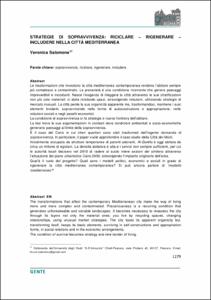Mostra el registre d'ítem simple
Strategie di sopravvivenza: riciclare – rigenerare – includere nella città mediterranea
| dc.contributor.author | Salomone, Veronica |
| dc.date.accessioned | 2015-05-18T14:09:59Z |
| dc.date.available | 2015-05-18T14:09:59Z |
| dc.date.issued | 2014-09 |
| dc.identifier.citation | Salomone, Veronica. Strategie di sopravvivenza: riciclare – rigenerare – includere nella città mediterranea. A: International Conference Virtual City and Territory. "9° Congresso Città e Territorio Virtuale, Roma, 2, 3 e 4 ottobre 2013". Roma: Università degli Studi Roma Tre, 2014, p. 1279-1287. |
| dc.identifier.isbn | 978-88-97524-15-1 |
| dc.identifier.uri | http://hdl.handle.net/2099/16451 |
| dc.description.abstract | Le trasformazioni che investono la città mediterranea contemporanea rendono l’abitare sempre più complesso e contaminato. La precarietà è una condizione ricorrente che genera paesaggi imprevedibili e incostanti. Nasce l’esigenza di rileggere la città attraverso le sue stratificazioni non più solo materiali: si abita riciclando spazi, stravolgendo relazioni, utilizzando strategie di mercato inusuali. La città perde la sua organicità apparente ma, trasformandosi, mantiene i suoi elementi fondanti, sopravvivendo nelle forme di autocostruzione e appropriazione, nelle relazioni sociali e negli assetti economici. La condizione di sopravvivenza si fa strategia e nuova frontiera dell’abitare. La tesi trova le sue argomentazioni in contesti dove condizioni ambientali e socio-economiche generano paesaggi al limite della sopravvivenza. È il caso del Cairo in cui interi quartieri sono stati trasformati dall’ingente domanda di sopravvivenza. In particolare, il paper vuole approfondire il caso studio della Città dei Morti. Inizialmente occupata da strutture temporanee di parenti adoranti, Al-Qarāfa è oggi abitata da circa un milione di egiziani. La densità abitativa è alta e i servizi non sempre sufficienti, per cui le autorità locali decisero nel 2010 di radere al suolo intere sezioni del cimitero attraverso l’attuazione del piano urbanistico Cairo 2050, stravolgendo l’impianto originario dell’area. Qual’è il ruolo del progetto? Quali sono i modelli politici, economici e sociali in grado di rigenerare la città mediterranea contemporanea? Si può ancora parlare di ‘modello mediterraneo’? |
| dc.description.abstract | The transformations that affect the contemporary Mediterranean city make the way of living more and more complex and contaminated. Precariousness is a recurring condition that generates unforeseeable and variable landscapes. It becomes necessary to reassess the city through its layers not only the material ones: you live by recycling spaces, changing relationships, using unusual market strategies. The city loses its apparent organicity but, transforming itself, keeps its basic elements, surviving in self-constructions and appropriation forms, in social relations and in the economic arrangements. The condition of survival becomes strategy and new border of living. The thesis finds its arguments in contexts where environmental and socio-economic conditions produce landscapes at the limits of survival. This is the case of Cairo where entire districts have been transformed by the huge demand of survival. In particular, the paper wants to deepen the study case of the City of the Dead. Initially occupied by temporary structures of adoring relatives, Al-Qarāfa is today inhabited by about a million of Egyptians. The population density is high and the services aren't always enough, so the local authorities decided in the 2010 to demolish entire sections of the cemetery through the implementation of the development plan Cairo 2050, changing the original structure of the area. What is the role of the project? What are the political, economic and social models capable of regenerating the contemporary mediterranean city? Can we still speak of 'Mediterranean model'? |
| dc.format.extent | 9 p. |
| dc.language.iso | ita |
| dc.publisher | Università degli Studi Roma Tre |
| dc.publisher | Centre de Política de Sòl i Valoracions |
| dc.relation.ispartof | International Conference Virtual City and Territory (9è: 2013: Roma) |
| dc.rights | Attribution-NonCommercial-NoDerivs 3.0 Spain |
| dc.rights.uri | http://creativecommons.org/licenses/by-nc-nd/3.0/es/ |
| dc.subject | Àrees temàtiques de la UPC::Desenvolupament humà i sostenible |
| dc.subject | Àrees temàtiques de la UPC::Urbanisme |
| dc.subject.lcsh | Cities and towns -- Egypt -- Cairo -- Growth |
| dc.subject.lcsh | Cemeteries -- Egypt -- Cairo |
| dc.subject.other | Sopravvivenza |
| dc.subject.other | Riciclare |
| dc.subject.other | Rigenerare |
| dc.subject.other | Includere |
| dc.title | Strategie di sopravvivenza: riciclare – rigenerare – includere nella città mediterranea |
| dc.type | Conference report |
| dc.subject.lemac | Desenvolupament urbà -- Egipte -- Caire |
| dc.subject.lemac | Cementiris -- Egipte -- Caire |
| dc.identifier.doi | 10.5821/ctv.8013 |
| dc.description.peerreviewed | Peer Reviewed |
| dc.rights.access | Open Access |
| local.citation.author | Salomone, Veronica |
| local.citation.contributor | International Conference Virtual City and Territory |
| local.citation.pubplace | Roma |
| local.citation.publicationName | 9° Congresso Città e Territorio Virtuale, Roma, 2, 3 e 4 ottobre 2013 |
| local.citation.startingPage | 1279 |
| local.citation.endingPage | 1287 |
| local.ordre | 115 |
Fitxers d'aquest items
Aquest ítem apareix a les col·leccions següents
-
09° Congresso Città e Territorio Virtuale, Roma, 2, 3 e 4 ottobre 2013 [142]
Città, Memoria, Gente


